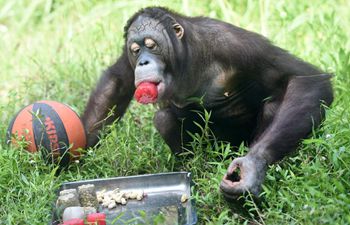WASHINGTON, July 16 (Xinhua) -- American and Chinese scientists have designed a diatom-like nanostructure which is inspired by the tiny, unicellular creature with multiple range of forms and producing close to a quarter of the oxygen on earth.
A study published on Monday in the journal Nature revealed that silica deposition could be effectively applied to synthetic, DNA-based architectures, improving their elasticity and durability.
It may ultimately have applications in new optical systems, semiconductor nanolithography, nano-electronics, nano-robotics and medical applications, such as drug delivery.
The researchers with Arizona State University (ASU) scientists, in collaboration with researchers from the Shanghai Institute of Applied Physics of the Chinese Academy of Sciences and Shanghai Jiaotong University, borrowed techniques used by naturally-occurring diatoms to deposit layer of silica to grow intricate shells.
Using a technique known as DNA origami, they designed nanoscale platforms of various shapes to which particles of silica, drawn by electrical charge, could stick, according to the study.
The ladder-like structure of the DNA double-helix is formed when complementary strands of nucleotides bond with each other, so this predictable behavior can be exploited in order to produce a virtually limitless variety of engineered shapes.
In the new study, the researchers showed the architectures designed with DNA, each measuring just billionths of a meter in diameter, could be used as structural frameworks on which diatom-like exoskeletons composed of silica could grow in a precise and controllable manner.
Once the DNA frameworks were complete, clusters of silica particles carrying a positive charge were drawn electrostatically to the surfaces of the electrically negative DNA shapes, accreting over a period of several days, like fine paint applied to an eggshell, according to the study.
Among the geometric DNA frameworks designed and constructed in the experiments were 2D crosses, squares, triangles and honeycomb shapes as well as 3D cubes, tetrahedrons, hemispheres, toroid and ellipsoid forms, occurring as single units or lattices.
Scientists have found that the silica architectures of diatoms are not only inspiringly elegant but exceptionally tough. The silica exoskeletons enveloping diatoms have the highest specific strength of any biologically produced material, including bone, antlers, and teeth.
In this study, researchers measured the resistance to breakage of their silica-augmented DNA nanostructures.
Like the natural counterparts, these forms showed far greater strength and resilience, displaying a 10-fold increase in the forces they could withstand, compared with the unsilicated designs, and they retained considerable flexibility as well.
The research has opened a pathway for nature-inspired innovations in nanotechnology in which DNA architectures act as templates that may be coated with silica or perhaps other inorganic materials, including calcium phosphate, calcium carbonate, ferric oxide or other metal oxides, yielding unique properties.
"We are interested in developing methods to create higher order hybrid nanostructures. For example, multi-layered/multi-component hybrid materials may be achieved by a stepwise deposition of different materials to further expand the biomimetic diversity," said Fan Chunhai from Shanghai Jiaotong University and one of the paper's author.

















